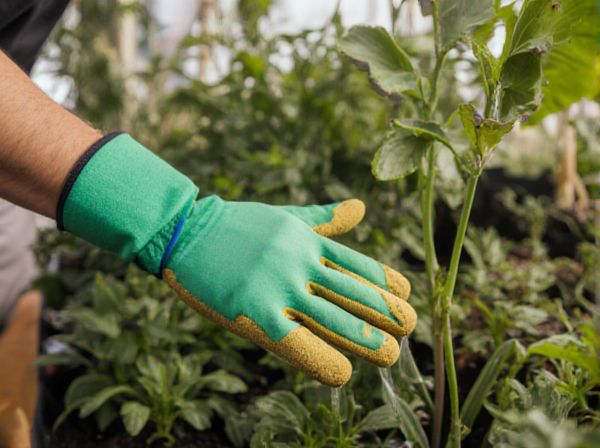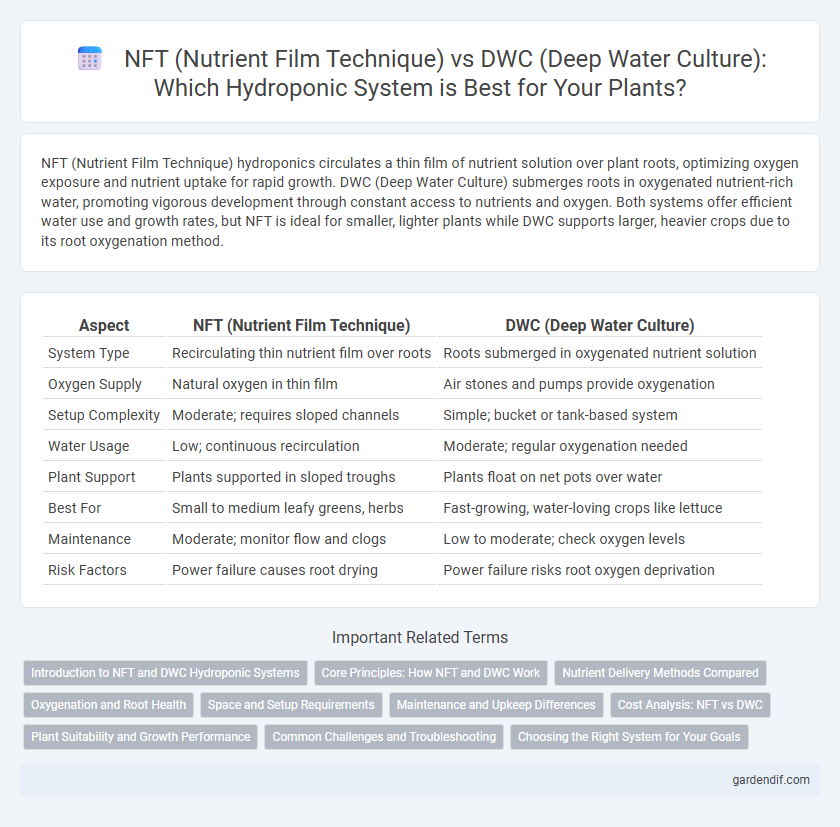
NFT (Nutrient Film Technique) vs DWC (Deep Water Culture) Illustration
NFT (Nutrient Film Technique) hydroponics circulates a thin film of nutrient solution over plant roots, optimizing oxygen exposure and nutrient uptake for rapid growth. DWC (Deep Water Culture) submerges roots in oxygenated nutrient-rich water, promoting vigorous development through constant access to nutrients and oxygen. Both systems offer efficient water use and growth rates, but NFT is ideal for smaller, lighter plants while DWC supports larger, heavier crops due to its root oxygenation method.
Table of Comparison
| Aspect | NFT (Nutrient Film Technique) | DWC (Deep Water Culture) |
|---|---|---|
| System Type | Recirculating thin nutrient film over roots | Roots submerged in oxygenated nutrient solution |
| Oxygen Supply | Natural oxygen in thin film | Air stones and pumps provide oxygenation |
| Setup Complexity | Moderate; requires sloped channels | Simple; bucket or tank-based system |
| Water Usage | Low; continuous recirculation | Moderate; regular oxygenation needed |
| Plant Support | Plants supported in sloped troughs | Plants float on net pots over water |
| Best For | Small to medium leafy greens, herbs | Fast-growing, water-loving crops like lettuce |
| Maintenance | Moderate; monitor flow and clogs | Low to moderate; check oxygen levels |
| Risk Factors | Power failure causes root drying | Power failure risks root oxygen deprivation |
Introduction to NFT and DWC Hydroponic Systems
NFT (Nutrient Film Technique) hydroponic systems utilize a thin, continuous flow of nutrient-rich water over plant roots, promoting efficient oxygenation and nutrient absorption. DWC (Deep Water Culture) submerges plant roots in a highly oxygenated nutrient solution, enabling rapid growth and high yields. Both methods optimize water and nutrient use, yet NFT is ideal for shallow-rooted crops while DWC suits larger plants requiring greater root expansion.
Core Principles: How NFT and DWC Work
NFT (Nutrient Film Technique) operates by circulating a thin film of nutrient-rich water over plant roots, ensuring constant access to oxygen and nutrients through a shallow stream in a tilted channel. DWC (Deep Water Culture) submerges plant roots in a highly oxygenated nutrient solution, using air stones or diffusers to maintain dissolved oxygen levels critical for root respiration and nutrient uptake. Both systems optimize nutrient delivery but differ fundamentally in root immersion and oxygenation methods, influencing growth rates and crop suitability.
Nutrient Delivery Methods Compared
NFT (Nutrient Film Technique) delivers a thin, continuous flow of nutrient-rich water over the roots, optimizing oxygen access and nutrient absorption for fast growth. DWC (Deep Water Culture) suspends plant roots directly in oxygenated nutrient solution, providing constant nutrient availability and promoting vigorous root development. NFT is ideal for lightweight, fast-growing plants, while DWC supports larger, heavy-feeding crops with stable nutrient immersion.
Oxygenation and Root Health
Nutrient Film Technique (NFT) enhances oxygenation by continuously flowing a thin nutrient film over plant roots, promoting optimal root respiration and preventing oxygen depletion. Deep Water Culture (DWC) submerges roots in oxygen-rich, aerated nutrient solutions, using air stones to deliver high dissolved oxygen levels critical for healthy root growth. Both NFT and DWC systems improve root health through superior oxygen availability but differ in water flow dynamics and oxygen diffusion efficiency.
Space and Setup Requirements
Nutrient Film Technique (NFT) systems require minimal space due to their compact channels that allow a thin film of nutrient solution to flow over plant roots, making them ideal for vertical or rooftops setups. Deep Water Culture (DWC) systems demand more space as plants are suspended in large oxygenated nutrient reservoirs, necessitating sturdy containers and support structures. NFT setups often involve a more complex installation with precise slopes and pumps, while DWC setups are simpler but bulkier due to the continuous deep water environment.
Maintenance and Upkeep Differences
NFT (Nutrient Film Technique) requires frequent monitoring and adjustment of the thin nutrient film to prevent clogging and ensure consistent flow, demanding regular cleaning and precise nutrient management. DWC (Deep Water Culture) involves maintaining oxygen levels in the water and monitoring root health, with periodic water changes and aerator upkeep being essential to prevent root rot and nutrient imbalances. NFT systems generally need more hands-on maintenance to sustain channel flow, while DWC emphasizes water quality and aeration stability.
Cost Analysis: NFT vs DWC
NFT (Nutrient Film Technique) systems generally require lower initial investment due to simpler infrastructure and reduced water volume compared to Deep Water Culture (DWC), which demands larger tanks and aeration equipment. Operational costs for NFT remain moderate as nutrient recycling is efficient, whereas DWC incurs higher energy expenses because of constant oxygenation and water circulation needs. In long-term cost analysis, NFT offers savings in maintenance and resource consumption, but DWC potentially delivers higher yields that might offset the increased operational expenses.
Plant Suitability and Growth Performance
NFT (Nutrient Film Technique) is best suited for fast-growing, small to medium-sized plants like lettuce and herbs due to its efficient nutrient delivery through a thin film of water, promoting steady root oxygenation and preventing root diseases. Deep Water Culture (DWC) supports larger, fruiting plants such as tomatoes and peppers by submerging roots directly in oxygenated nutrient-rich water, enabling rapid growth and higher yields through constant nutrient availability. Growth performance in NFT systems tends to be more stable under controlled conditions, while DWC systems allow for accelerated biomass accumulation but require careful monitoring of oxygen levels to avoid root hypoxia.
Common Challenges and Troubleshooting
NFT (Nutrient Film Technique) systems often face challenges with film flow inconsistency and root oxygenation, requiring regular channel inspection and pump maintenance to prevent nutrient imbalance and root rot. DWC (Deep Water Culture) systems commonly encounter oxygen depletion and water temperature fluctuations, necessitating the use of air stones and temperature regulators for optimal root health. Both systems require vigilant monitoring of pH levels and nutrient concentration to mitigate plant stress and ensure productive growth cycles.
Choosing the Right System for Your Goals
NFT (Nutrient Film Technique) offers a continuous flow of nutrient solution over plant roots, optimizing oxygen exposure and nutrient uptake, ideal for fast-growing crops and space-efficient setups. DWC (Deep Water Culture) submerges roots in oxygenated nutrient-rich water, promoting vigorous growth and higher yields, suited for larger, water-tolerant plants. Selecting between NFT and DWC depends on crop type, available space, system maintenance preferences, and desired growth speed.
NFT (Nutrient Film Technique) vs DWC (Deep Water Culture) Infographic

 gardendif.com
gardendif.com